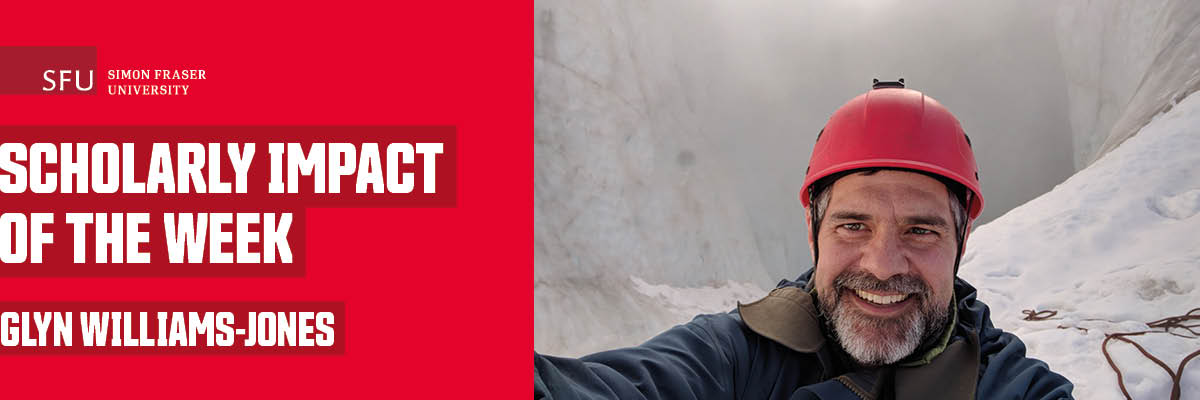
Simon Fraser University (SFU) Earth Sciences Professor and Chair Glyn Williams-Jones has studied major volcanoes all over the world. His research supports climate change adaptation and resilience by helping Canadian communities understand and prepare for specific climate-related threats. He is one of many SFU researchers working with partners on community-centred climate innovation. Recently, he and his team have been studying the potential hazards of an active volcano close to home.
The Mount Meager (Qw’elqw’elústen) Volcanic Complex 80 km northwest of Pemberton, British Columbia, last erupted approximately 2400 years ago with a significant explosion that sent volcanic ash all the way to Alberta. Part of the Garibaldi Volcanic Belt—situated in the Pacific Ring of Fire—Mount Meager is considered one of Canada’s most threatening volcanoes, due to its proximity to population centres.
Volcanologist Williams-Jones and his research team have made numerous trips to the Mount Meager Complex and observed how thinning glaciers caused by climate change is revealing fumaroles—volcanic gas vents in the mountain. He is concerned that the combination of acid gases and fluids within the mountain and melting ice cover is making Mount Meager increasingly unstable. In 2010, a major landslide occurred, sending 53 million cubic metres of debris sliding down the mountain—the largest recorded landslide in Canada.
Williams-Jones notes that the landslide threat would be exacerbated by volcanic activity at the complex, of which little research has been done. He and his collaborators set about assessing the danger of a volcanic eruption and identified major hazards including the potential for dome-collapse, mud and debris flows, and tephra fall—the deposit of ash into the environment.
In his recent paper A scenario-based volcanic hazard assessment for the Mount Meager Volcanic Complex, British Columbia, he describes the threats considered. The paper was led by SFU Master of Science researcher Rachel Warrick, and co-authored with Geological Survey of Canada’s Melanie Kelman and Principal Geoscientist at Innovate Geothermal Jeffrey Witter.
We spoke with Professor Williams-Jones about his work.
Tell us about the threats you have observed at Mount Meager. Is any one scenario more imminent than others?
The most imminent and likely threat from Meager is the chance of landslides. However, while activity is low, Meager is still an active volcano. Due to the presence of glaciers on its summit, future volcanic activity could involve melting of the glacier and development of lahars or volcanic debris flows. We also know from the last eruption 2400 years ago that it has erupted large volumes of volcanic ash which can travel for many hundreds of kilometers and impact infrastructure and human health.
Explain how climate change has the potential to “wake up” volcanoes.
In countries like Iceland, large ice sheets up to a kilometer thick can act to keep the ‘lid on the pressure cooker.’ As these glaciers melt, there may be a drop in pressure making the gases that drive volcanic eruptions more likely to bubble out.
At Mount Meager, climate change is also driving rapid melting of much thinner alpine glaciers and permafrost, which can change water flow in the already altered and weakened slopes leading to potentially very large landslides. If—a big if—the magma chamber was already at a tipping point, a large landslide could remove the ‘pressure cooker lid’ and maybe trigger an eruption. A lot of dominoes would have to line up, but this is a scenario we are hoping to model.
You contributed to Natural Resources Canada’s Resilient Pathways Report: Co-creating New Knowledge for Understanding Risk and Resilience in B.C. Tell us about the gaps in the risk assessment of B.C. volcanoes—how concerning is this?
The two biggest gaps in volcano risk assessment in B.C. and the Yukon is the lack of good geological mapping, dates of past events, and monitoring. Knowing dates of the previous volcanic eruptions is critical to understanding what to expect of future activity—while monitoring is crucial to detecting the early precursory signals of change in a volcano leading up to an eruption.
As co-director of the Centre for Natural Hazards Research (CNHR) you work with an interdisciplinary team from across B.C., Canada and the world. What range of disciplines are represented and how important is this collaboration to understanding geophysical phenomena?
The CNHR has experts with a depth of knowledge in hazards ranging from earthquakes, wildfires and landslides to flooding, climate change and even volcanoes. As many of these events can be cascading hazards—for example, an earthquake triggers a landslide which dams a river leading to flooding—it is incredibly important to have a broad group of collaborators able to bring their expertise to tackle a given research problem.
You recently visited Mount Meager with a delegation of cave rescue experts, university researchers and representatives from NASA’s jet propulsion laboratory. Can you tell us why NASA and others are interested in the mountain?
This expedition was supported by the Royal Geographical Society of Canada and brought together cave access and rescue experts along with scientists and engineers from NASA’s Jet Propulsion Laboratory and the University of Tennessee Knoxville. The aim was to measure the temperature and gas compositions of fumaroles beneath the glacier in glaciovolcanic caves filled with toxic levels of gas. It is also an ideal natural laboratory to explore for the presence of extremophiles—extreme microbes—and test robots for eventual deployment to the icy moons of Saturn and Jupiter.
For more: Visit the Physical Volcanology Research Group at SFU and the CBC story and photos of Mount Meager.
Learn more about SFU’s commitment to community-centred climate innovation: www.sfu.ca/climate-innovation.
SFU's Scholarly Impact of the Week series does not reflect the opinions or viewpoints of the university, but those of the scholars. The timing of articles in the series is chosen weeks or months in advance, based on a published set of criteria. Any correspondence with university or world events at the time of publication is purely coincidental.
For more information, please see SFU's Code of Faculty Ethics and Responsibilities and the statement on academic freedom.